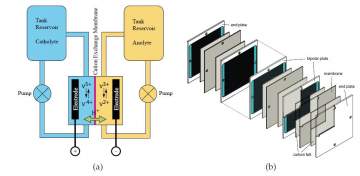
components composing a VRB stack. The surfaces in contact with the catholyte are coloured
in blue and in orange for the anolyte.
Introduction:
Vanadium redox flow batteries (VRB) are large stationary electricity storage systems with
many potential applications in a deregulated and decentralized network. Flow batteries (FB)
store chemical energy and generate electricity by a redox reaction between vanadium ions
dissolved in the electrolytes. FB are essentially comprised of two key elements (Fig. 1): the
cell stacks, where chemical energy is converted to electricity in a reversible process, and the
tanks of electrolytes where energy is stored.
The most significant feature of the FB is maybe the modularity of their power (kW) and energy
(kWh) ratings which are independent of each other. In fact, the power is defined by the size
and number of cells whereas the energetic capacity is set by the amount of electrolyte stored
in the reservoirs. Hence, FB can be optimized for either energy and/or power delivery.
Over the past 30 years, several redox couples have been investigated (Bartolozzi, 1989): zinc
bromine, polysulfide bromide, cerium zinc, all vanadium, etc. Among them, VRB has the best
chance to be widely adopted, thanks to its very competitive cost, its simplicity and because it contains no toxic materials.
In order to enhance the VRB performance, the system behaviour along with its interactions
with the different subsystems, typically between the stack and its auxiliaries (i.e. electrolyte
circulation and electrolyte state of charge), and the electrical system it is being connected to,
have to be understood and appropriately modeled. Obviously, modeling a VRB is a strongly
multidisciplinary task based on electrochemistry and fluid mechanics. New control strategies,
based on the knowledge of the VRB operating principles provided by the model, are proposed
to enhance the overall performance of the battery.
Click above icon for the FULL PDF version
